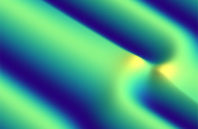New research from the Massachusetts Institute of Technology (MIT) demonstrates that light-generated phase changes occur differently than phase changes triggered by temperature. While optically induced phase changes have been observed before, the mechanism through which they proceeded was not known. Additional understanding of the process could lead to new types of optoelectronic devices, such as devices for data storage.
To study light-induced phase change, the researchers used an electron density modulation frozen within a solid. This electronic analog, called a charge density wave, mimics the characteristics of a crystalline solid.
The research team found that during optically induced melting, the phase change generated many topological defects in the material. These defects, which researchers compared to vortices on the surface of water, changed the dynamics of the electrons and lattice atoms in the material.

 (585) 768-2513
(585) 768-2513

